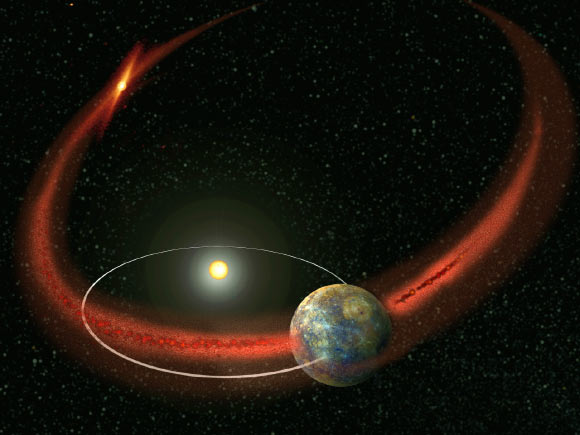Mercury – the smallest planet in our Solar System – appears to get hit by recurring meteor showers, possibly associated with Comet 2P/Encke.

Mercury appears to undergo seasonal meteor showers. Image credit: NASA’s Goddard Space Flight Center.
First discovered by French astronomer Pierre Méchain in 1786 and named after Johannes Encke who calculated its orbit in 1821, 2P/Encke is a periodic comet that completes an orbit of the Sun once every 3.3 years.
This comet is believed to be the originator of the Southern and Northern Taurids, meteor showers that peak in October and November, and the Beta Taurids in June and July.
The clues pointing to Mercury’s periodic showers caused by the 2P/Encke’s debris have been discovered in the very thin halo of gases that make up the planet’s exosphere, which is under study by NASA’s MESSENGER spacecraft.
Measurements taken by the Mercury Atmospheric and Surface Composition Spectrometer (MASCS) instrument on board MESSENGER have revealed seasonal surges of calcium that occurred regularly over the first nine Mercury years since the space probe began orbiting the planet in March 2011.
The suspected cause of these spiking calcium levels is a shower of small dust particles hitting the planet and knocking calcium-bearing molecules free from the surface.
This process, called impact vaporization, continually renews the gases in Mercury’s exosphere as interplanetary dust and meteoroids rain down on the planet. However, the general background of interplanetary dust in the inner Solar System cannot, by itself, account for the periodic spikes in calcium. This suggests a periodic source of additional dust, for example, a cometary debris field.
“If our scenario is correct, Mercury is a giant dust collector. The planet is under steady siege from interplanetary dust and then regularly passes through this other dust storm, which we think is from 2P/Encke,” said Dr Joseph Hahn from the University of Texas at Austin’s Space Science Institute, the senior author of the paper published in the journal Icarus.
Dr Hahn and his colleague, Dr Rosemary Killen of NASA Goddard Space Flight Center in Greenbelt, created detailed computer simulations to test their hypothesis.
However, the calcium spikes found in the MASCS data were offset a bit from the expected results.
“This shift is probably due to changes in the comet’s orbit over time, due to the gravitational pull of Jupiter and other planets,” the scientists said.
_____
Rosemary M. Killen & Joseph M. Hahn. Impact Vaporization as a Possible Source of Mercury’s Calcium Exosphere. Icarus, published online December 10, 2014; doi: 10.1016/j.icarus.2014.11.035







